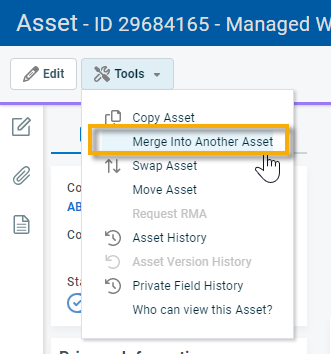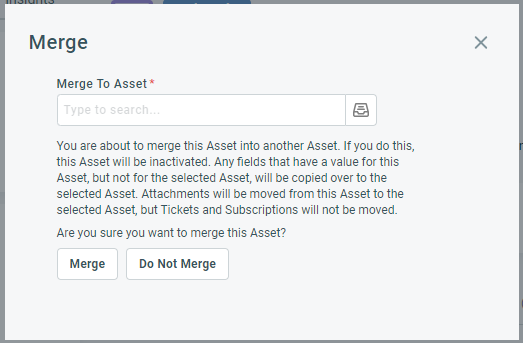Merging entities
About merging
Duplicate records are created all the time. They create confusion and billing hassles. To resolve duplicates, Autotask contains merge utilities that are used to combine duplicate entities. They all work the same way:
- You identify a duplicate record (or multiple records in the case of tickets) that you want to merge into another one. This is the source entity.
- You identify the record (usually the one with the most activity) that you want to retain. This is the destination entity.
- Notes, entities and accessories associated with the source entity are transferred to the destination entity.
- The source entity is deactivated or deleted.
- Notes are added to both entities recording the merge.
The following Autotask entities have a merge utility:
- Contacts: Contact merge allows you to combine all opportunities, to-dos, notes (activities), tickets, project tasks, and billing rules associated with one contact into another contact at the same organization.
- Devices: Device merge allows you to merge duplicate devices into one device.
- Organizations: Organization merge allows you to merge data from one organization to another organization.
- Tickets: Ticket merge and ticket absorb are used to combine two or more tickets for the same issue from the same organization. Ticket merge options are bidirectional depending on which ticket you want to keep open and which ticket you are currently working in. To keep the current ticket open, you would "absorb" other tickets into it. To close the current ticket and transfer its contents into another ticket, you would "merge" it into the other ticket. Refer to Merging tickets.
Merging process
Refer to Merging tickets.
PERMISSIONS Security level with Admin permission to configure Organizations & Contacts. Refer to Organizations & Contacts.
NAVIGATION Left Navigation Menu > Admin > Admin Categories > Features & Settings > Organizations & Contacts > Utilities > Organization Merge
The Organization Merge utility is designed to deal with duplicate organization records.
Before you merge organizations, it is best practice to clearly identify the source organization, maybe by appending " - Delete" to the organization name.
To merge a source organization into a destination organization, do the following:
- To open the page, use the path(s) in the Security and navigation section above.
- Click the data selector icon
 next to the Source Organization field. The Organization Search page opens. Navigate to the organization you want to merge into another organization and select it. The selected organization will populate the Source Organization field.
next to the Source Organization field. The Organization Search page opens. Navigate to the organization you want to merge into another organization and select it. The selected organization will populate the Source Organization field. - Optionally, select the Delete Source Organization check box to delete the duplicate organization record.
If you do not, all contacts, opportunities, to-dos and notes will be transferred to the Destination Organization record, but the old organization record will be retained. In that case, you should change the organization name of the source organization to indicate that the organization record is not a valid choice, and inactivate it.
NOTE As long as the organization type is not set to Customer, users with Delete permission for organizations can manually delete the organization in CRM.
- Click the data selector icon
 next to the Destination Organization field. On the Organization Search page, locate and select the organization you want to merge the data into.
next to the Destination Organization field. On the Organization Search page, locate and select the organization you want to merge the data into. - Click Merge to move the data from the source organization to the destination organization.
NOTE If the source organization's create date is earlier than the destination organization's, it will become the create date for the merged organization.
When you merge organizations, the following will happen:
- Contracts get moved from the Source Organization to the Destination Organization, so billing rules will be moved with those contracts. Contact and/or devices are also moved from the source organization to the destination organization, so contact and device associations to billing products will also be carried over.
- Contacts do not get combined.
- Change advisory boards get moved from the Source Organization to the Destination Organization.
- If the Source Organization create date is earlier than the Destination Organization create date, the Source Organization date becomes the organization create date for the merged organization.
- Organization locations will be transferred to the destination organization.
- The source organization's primary location is transferred to the destination organization using the source organization's name. Refer to What happens to organization locations when you merge?
- If the source organization had a primary address and we are not deleting the source organization, the primary location will be merged to the destination organization, and the source organization will keep a copy of their primary address.
- If there are duplicate location names, a number is appended to the location name.
EXAMPLE Source organization has location "Chicago", destination organization has location "Chicago". After the merge, the destination organization will have "Chicago" and "Chicago (2)".
-
If you do not delete the Source Organization with the check box, users with Delete permission for organizations can do it manually from CRM.
- Organization locations will be transferred to the destination organization.
- The source organization's primary location is transferred to the destination organization using the source organization's name.
- If there are duplicate location names, a number is appended to the location name.
EXAMPLE Source organization has location "Chicago", destination organization has location "Chicago". After the merge, the destination organization will have "Chicago" and "Chicago (2)".
- If the source organization had a primary address and we are not deleting the source organization, the primary location will be merged to the destination organization, and the source organization will keep a copy of their primary address.
- Contracts get moved from the source organization to the destination organization, so billing rules will be moved with those contracts. Contacts and devices are also moved from the source organization to the destination organization, so the contact and device associations to billing products will also be carried over.
The following source organizations cannot be merged into another organization:
- Your local organization (organization ID 0). It has special functions in Autotask. Refer to Your local organization in Autotask.
- Source Organizations that are or ever have been mapped to a Kaseya module organization for Integrated Customer Billing. Refer to Integrated Customer Billing and Mapping Autotask organizations to module organizations.
- Source Organizations that are or ever have been associated with a processed payment. Refer to Payment Processing.
- Organizations that are set up as an outsource partner.
- If Multi-currency is enabled, source organizations that have a different currency from the destination organization.
PERMISSIONS Security level with Admin permission to configure Organizations & Contacts. Refer to Organizations & Contacts.
NAVIGATION Left Navigation Menu > Admin > Admin Categories > Features & Settings > Organizations & Contacts > Utilities > Contact Merge
Contact Merge is a utility that allows you to merge all opportunities, to-dos, notes (activities), tickets, project tasks and billing rules associated with one contact into another contact at the same organization. This utility is used to delete duplicate contacts. A contact merge cannot be undone.
If the source contact is associated with a processed payment, it cannot be merged into another contact. Refer to Payment Processing.
NOTE If a contact that is an additional contact on a ticket gets merged into another contact, the Merge To contact will replace the Merge From contact as an additional contact on the ticket. However, they will not be added as an additional contact if they are being merged into the contact that is already the primary resource on the ticket or is already an additional contact on the ticket.
To merge a contact into another one, do the following:
- To open the page, use the path(s) in the Security and navigation section above.
- Click the data selector icon next to the Source Contact field.
The Select Contact page opens.
- Navigate to the contact you want to merge into another contact and select it. The selected contact populates the Source Contact field.
TIP Use the First Name or Last Name fields to narrow your contact search.
- Check the Delete check box to delete the duplicate contact record. If you do not, all opportunities, quotes, to-dos, activities, tickets and project tasks will be transferred to the Destination Contact record, but the duplicate contact record will be retained.
- Click the data selector icon next to the Destination Contact field.
- Navigate to and select the contact you want to merge the data into. The selected contact populates the Destination Contact field.
- Click Merge to complete your merge.
NOTE Client Portal users cannot be deleted. We recommend that you inactivate these contacts after merging their associated information to another contact.
- If a contact that is an additional contact on a ticket gets merged into another contact, the Merge To contact will replace the Merge From contact as an additional contact on the ticket. However, they will not be added as an additional contact if they are being merged into the contact that is already the primary resource on the ticket or is already an additional contact on the ticket.
- Client Portal users cannot be deleted. We recommend that you inactivate these contacts after merging their associated information to another contact.
PERMISSIONS Permission to edit devices.
NAVIGATION
• Device Search > context menu
• Device Widget Drill-in tables > context menu
• Device > Tools
• Devices > accessory tabs > Related Items
- From the Device page Tools menu or the device search table context menu, select Merge into another Device.

The Merge dialog box opens:
- Click the data selector icon and select the device you want to merge into.
NOTE Devices with a category of SSL Certificate and Domain can only be merged into a device with the same category. Fields that are not specific to those categories, as well as UDFs, will follow normal merge rules. Details specific to the Domain and SSL Certificate categories will not be merged.
-
Click Merge.
Merging devices for Autotask integrations is dependent upon the device identification number. This is either the ID for the device set by the integration or the Autotask ID assigned when a device is manually created.
- A device with a Datto RMM device ID and/or a Datto BCDR device ID cannot be merged unless the device you are merging into has same device ID. You can merge non-RMM/BCDR devices into RMM/BCDR devices, but not the other way round.
- Other integrations that store the Autotask internal ID in their own system cannot be merged unless the vendor has explicitly stated they handle the case.
- The merged from devices gets inactivated.
-
Any fields that have a value for this device, but not for the selected device, will be copied over to the selected device.
- A note is added to the merge from and merge to device noting the merge.
- Attachments and notes are transferred to the merged to device.
- Tickets and subscriptions are not transferred, and relationships between devices are not altered.
- Edit workflow rules will fire if any changes are made to the merge from or merge to devices.
- A row will be added to the Device History. The merge from device's history row will say Merged in the action column, while the merge to will say Absorbed. This action will also be date/time stamped with the name of the resource that initiated it.



